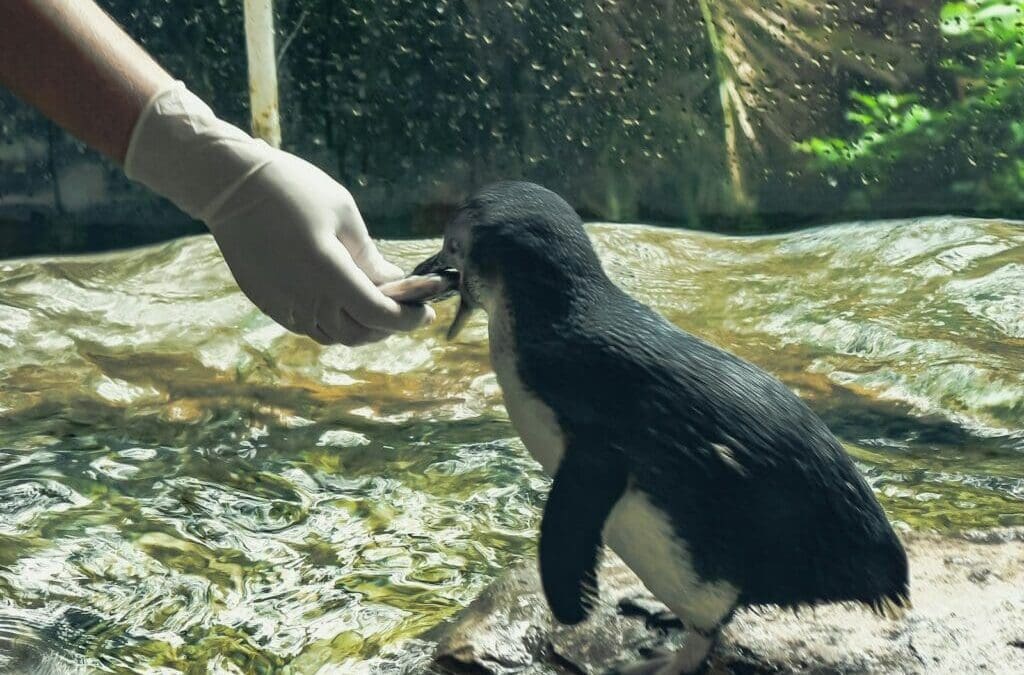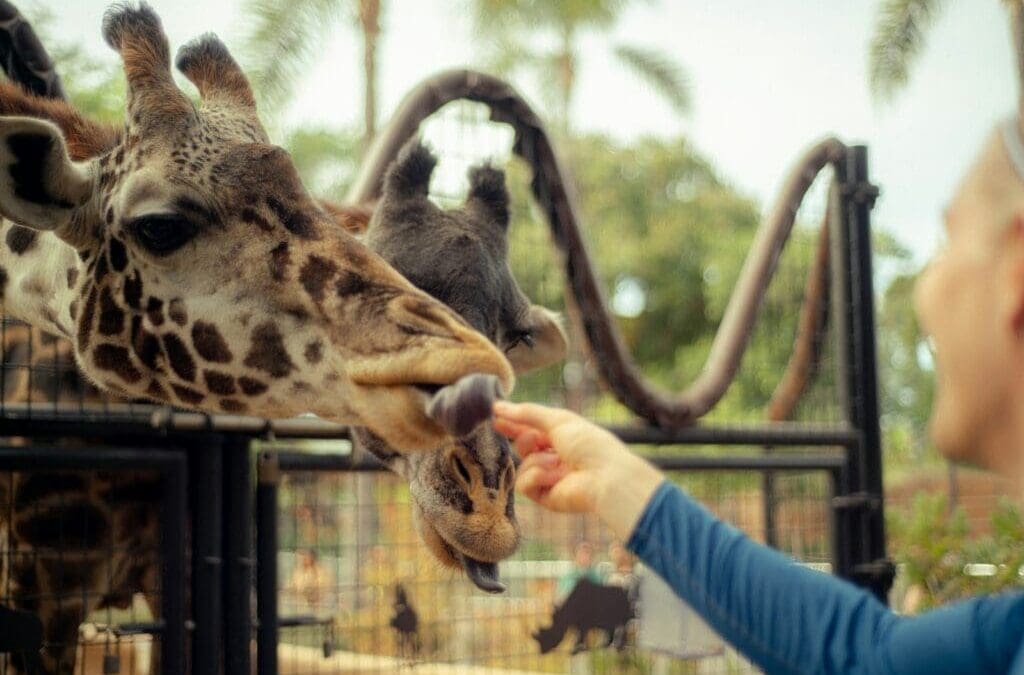
by pixeladmin7 | Apr 22, 2024 | General, Zoo Management & Operations
Photo by K. Mitch Hodge on Unsplash
Zoo Researchers’ Daily Grind – Unveiling the Dedicated Wildlife Guardians
Visiting a zoo offers a glimpse into the lives of animals from around the globe, but the true heartbeat of these conservation centers lies in the day-to-day endeavors of zoo researchers. These dedicated scientists engage in a variety of crucial tasks that often go unnoticed by the public. From analyzing animal behavior to conducting vital conservation efforts, their work is essential in enhancing our understanding of wildlife and ensuring the health and well-being of zoo inhabitants.
The daily grind for these researchers involves more than just observing animals. It’s a complex routine that intertwines care, science, and education. They may start their mornings collecting samples for study, such as examining feces to extract hormones, as seen in the work of zoo scientist Rachel Santymire. These samples can reveal a wealth of information about an animal’s health and reproductive status, contributing to broader efforts in species preservation. This meticulous work behind the scenes is as rewarding as it is challenging, reflecting a deep commitment to animal conservation.
Moreover, behind-the-scenes tours provide a unique perspective on what goes into animal care and research at these facilities. They offer visitors a chance to meet animals up close and learn about the complex care regimens that are involved in maintaining the health of these creatures. For instance, the Saint Louis Zoo offers encounters that allow for an intimate understanding of the roles researchers play in zoo operations and animal welfare. By shedding light on these behind-the-scenes activities, we gain a deeper appreciation for the tireless efforts of the individuals devoted to preserving Earth’s precious wildlife.
A Day in the Life of Zoo Researchers
Zoo researchers play a critical role in understanding animal behavior, ensuring animal welfare, and contributing to conservation efforts. They operate behind the scenes, where their daily grind revolves around care for a diverse array of animals, from fish to tigers.
Understanding Animal Behavior
Zoo researchers start their day by observing animals in their habitats, paying close attention to behaviors that might indicate the animals’ needs or well-being. For example, they might note the social dynamics of a troop of lemurs or monitor an elephant’s response to its environment. This direct observation is critical to understanding the subtle nuances of animal behavior, which can inform care strategies and help promote positive welfare outcomes.
The Importance of Enrichment
Part of a zoo researcher’s responsibility includes orchestrating enrichment activities that stimulate the animals mentally and physically. Whether it involves complex puzzle feeders for birds such as parrots, or innovative foraging games for giraffes, these activities aim to mimic challenges animals would encounter in the wild, thereby enhancing their life in captivity.
Documenting and Collecting Data
Each interaction with the animals, whether routine care or during enrichment exercises, is meticulously documented. Researchers collect data ranging from dietary intake to behavioral responses and feces analysis. For species like the endangered tortoise, these data are invaluable to wildlife conservation, aiding in breeding programs and helping to ensure the longevity of these treasured beings. Similarly, the analysis of tiger behaviors can guide conservation practices both in zoos and in the animals’ native habitats.
Zoo Conservation Efforts
Zoo conservation efforts play a pivotal role in safeguarding endangered species and improving animal welfare through dedicated programs and initiatives.
Species Preservation Programs
Zoos are at the forefront of wildlife conservation, orchestrating Species Preservation Programs that are crucial for the survival of many endangered species. They participate in carefully managed breeding plans to increase population numbers, an approach that has proven successful for species like elephants and tigers, which are often the stars of the show in terms of conservation.
For example, the Association of Zoos and Aquariums (AZA) designs Species Survival Plans® that collaborate internationally to ensure genetically diverse and demographically stable populations. Meanwhile, behind the scenes, zoo researchers meticulously track genetic information and orchestrate transfers of animals between institutions to support genetic diversity.
Habitat and Welfare Improvement
The welfare of animals in captivity is a paramount consideration, and zoos invest considerable resources into Habitat and Welfare Improvement. Recognizing that an animal’s well-being is intrinsically linked to the quality of its habitat, zoos strive to mimic natural environments, which encourages natural behaviors, thus enhancing the animals’ quality of life.
Through collaborations and research, zoo biologists and veterinarians gain insight into the specific needs of different species. Zoo Atlanta’s research emphasizes that understanding the intricacies of each species’ natural habits and habitats informs the design of zoo enclosures and enrichment activities. These efforts extend beyond the confines of the zoo, as institutions also engage in in-situ conservation, working to preserve and restore natural habitats, ensuring the long-term sustainability of wildlife conservation.
Engaging the Public
Zoos have evolved to offer more immersive experiences to visitors, aiming to educate and connect the public with wildlife conservation efforts. These engagements through meticulously planned events and backstage interactions not only enhance public knowledge but also foster a deeper appreciation for wildlife.
Educational Events and Programs
Zoos organize a variety of educational events and programs tailored to audiences of all ages. From wildlife conservations talks to interactive demos, these programs serve to enlighten visitors about the intricate behaviors and habitats of different species. Families and small groups are often encouraged to participate in these events, which may include activities like animal feeding demonstrations, allowing them to gain hands-on experience and build lasting memories through direct involvement.
Behind-the-Scenes Experiences
The behind-the-scenes experiences offer a sneak peek into the day-to-day work of zoo keepers. These exclusive tours provide small groups or members a chance to see what goes on beyond the public displays at the zoo. These encounters may include visiting medical facilities, observing animal training sessions, or even participating in the preparation of animal diets. The interactive nature of these experiences allows individuals to ask questions and learn directly from the experts, gaining insights into the critical role zoos play in species conservation.

by pixeladmin7 | Apr 15, 2024 | General, Zoo Management & Operations
Photo by Angel Luciano on Unsplash
Creating Environments that Mimic Natural Habitats for Happy, Healthy Animals
Designing a zoo goes beyond the placement of enclosures and the selection of animals. It’s about recreating natural habitats that not only cater to the intricate needs of wildlife but also offer educational value to visitors. Modern zoo design emphasizes the replication of these natural habitats as closely as possible, ensuring that inhabitants thrive in environments akin to their wild counterparts. This approach supports both the physical and psychological well-being of the animals, providing spaces where they can express natural behaviors.
The role of zoos has evolved from mere exhibition to conservation and education. Exhibits are crafted to engage visitors, offering immersive experiences that raise awareness about the diverse ecosystems these animals hail from. Ensuring that environments mimic natural habitats is not only ethically responsible but also critical for the successful conservation of species. Through thoughtful zoo design, visitors are treated to a glimpse of the natural worlds that many animals call home, fostering a deeper connection between humans and wildlife.
Zoo designers and animal welfare experts collaborate to create habitats that serve as facsimiles of the diverse terrains that cover our planet—from the dense foliage of rainforests to the arid stretches of savannas. This attention to detail guarantees that a trip to the zoo is more than just an opportunity to see exotic animals; it’s an educational journey that emphasizes the importance of preserving these species in the wild. The fusion of landscape artistry with animal husbandry science transforms the traditional zoo into a sanctuary for wildlife and a center for conservation education.
Understanding Natural Habitats
In zoo design, closely replicating the natural habitats of animals is essential for their well-being and visitor engagement. The creation of these environments calls for a deep comprehension of the original ecosystems from which the animals hail, integrating vegetation, climate, and other habitat-specific elements effectively.
Importance of Mimicking Natural Ecosystems
Mimicking natural ecosystems in zoos is vital for several reasons. For animals, it provides psychological benefits by allowing them to exhibit their natural behaviors, which is crucial for their overall health. For example, the Polar Bear exhibit at the Maryland Zoo showcases how incorporating pools of water and artificial rocks similar to an arctic coast promotes natural foraging behaviors in polar bears. Moreover, these authentic habitats educate visitors on the importance of habitat conservation and the impact of climate change and habitat loss on wildlife.
Challenges in Replicating Wild Conditions
Recreating the complexity of the wild presents multiple challenges. These challenges range from ensuring the perfect climate conditions are met for different species to replicating the intricate balance of an ecosystem where every flora and fauna has a role. Additionally, as habitats are often degraded due to human activity, conservationists must also innovate, sometimes creating artificial habitat structures to support species that have lost their natural environments. The constant evolution of the understanding of animal needs and natural environments contributes to the ongoing complexity of zoo habitat design.
Designing Enclosures for Animal Well-being
Creating habitats that foster animal health is crucial in modern zoos. Designers focus on exercise, social needs, and psychological enrichment to ensure animals thrive. Here’s a closer look at the specific needs for various species:
Mammals: Spaces should include climbing structures and hiding spots, especially for monkeys and big cats like lions and tigers, to encourage natural behaviors.
Birds: Avian enclosures require vertical space for flight and varied perches to facilitate movement and promote wing health.
Giraffes: Tall enclosures with foliage at different heights enable natural feeding behaviors.
Elephants: As social creatures, they need large, complex environments that allow for socialization and plenty of room to roam.
Reptiles: Temperature-controlled areas with places to bask and hide are essential.
Hippos: Aquatic spaces paired with land areas mimic their natural riverine habitats.
Penguins: Need both swimming areas and land, with climate control to mimic icy home environments.
Polar bears: Require cold, expansive enclosures with water for swimming.
An example of such enclosures is seen in the approach where diverse vegetation and terrain variations are utilized to simulate the wild, encouraging exploration and activity. Also, climate control is vital for species like penguins and polar bears, ensuring their habitats reflect the cold conditions of their arctic origins.
The goal is always to create an environment that not only resembles their wild counterparts but also promotes physical activity and mental well-being, which are key components of overall animal health.
Integrating Visitor Experience
Creating environments within zoos that enhance the visitor experience involves careful planning to ensure that both educational value and entertainment are woven seamlessly into the design. Visitors should leave with a greater understanding of the animals they’ve seen and the ecosystems they inhabit, all within accessible, safe, and considerate viewing areas.
Educational and Ethical Considerations
Zoos play a crucial role in education and conservation, often fostering a connection between society and wildlife. When integrating visitor experiences, it is essential to design exhibits that provide educational content that raises awareness of the animals’ natural habitats and the conservation efforts in place to protect them. Signage, interactive displays, and informed staff are integral to imparting knowledge without compromising the welfare of the animals.
Example Educational Elements:
Informational Graphics: Visitors can learn about the diet, behaviors, and conservation status of each species.
Conservation Messages: Strategic placement encourages visitors to engage with environmental issues and learn how they can contribute.
Innovative Viewing Methods
In response to increasing competition with other forms of entertainment, zoos are innovating new ways for visitors to observe animals. Safari parks, aquariums, and even arts and architecture are combining to create immersive experiences that contrast with traditional zoos’ viewing methods. Glass tunnels, elevated walkways, and underwater viewing areas provide unique perspectives of animal behavior and habitats.
Examples of Viewing Techniques:
Elevated Walkways: Allow visitors to walk among the tree canopies, observing arboreal species at eye level.
Glass Tunnels: Offer immersive experiences, especially in aquarium settings, where visitors can appreciate marine life swimming above them.
By focusing on education and innovative viewing, zoos not only boost attendance but also reiterate their role in conservation and education within a modern society.
Sustainability and Conservation Efforts
In the realm of zoo design, the emphasis on sustainability is paramount. It serves a dual purpose: promoting endangered species recovery and fore fronting innovative practices that reduce the ecological footprint. One approach is incorporating climate control technologies, which enable the creation of specific microenvironments that mimic the natural habitats of various species.
Conservation initiatives are woven into the fabric of modern zoos. They are pivotal in maintaining genetic diversity and supporting species that are threatened in the wild. Programs focused on endangered species aim to engage visitors, highlighting the fragility and significance of these animals.
Native species benefit too. Zoos are increasingly mindful of indigenous fauna and flora, dedicating resources towards habitats that foster and protect local biodiversity. This often involves reintroducing species into their natural ecosystems, a practice firmly rooted in ecology.
Projects include:
Artificial habitats: Designed to replicate lost or degraded natural structures.
Resource conservation: Water recycling and renewable energy sources.
Education: Interactive displays teaching the importance of conservation efforts.
Ultimately, a sustainable zoo contributes significantly to conserving biodiversity by supporting endangered species, restoring natural habitats, and advancing ecological knowledge.

by pixeladmin7 | Jan 29, 2024 | General, Zoo Management & Operations
Photo by Troy Spoelma on Unsplash
Enhancing Health in Modern Zoos
Innovative approaches to animal nutrition in modern zoos represent a pivotal evolution in ensuring the welfare of animals in captivity. Nutritional science in zoos does much more than just satisfy hunger; it is an intricate process tailored to the unique dietary needs of each species, playing a crucial role in their overall health, behavior, and quality of life. By simulating the natural diets of animals as closely as possible, zoos are able to promote natural foraging behaviors, reinforcing the physical and psychological well-being of the zoo inhabitants.
The importance of proper animal nutrition extends beyond individual health—zoo nutrition is integral to global conservation efforts. Through carefully planned feeding programs, zoos contribute to the sustainability and reproductive success of endangered species, thereby supporting biodiversity. Additionally, these practices offer invaluable data for research, advancing scientific understanding of species-specific dietary requirements and leading to breakthroughs in both in-situ and ex-situ conservation strategies.
Education is another critical component of nutrition programs in zoos, with the feeding process serving as an educational tool for visitors. As they observe feeding sessions, the public gains insight into the complexity of animal care, the natural behaviors of different species, and the challenges involved in conservation work. Through these interactive learning experiences, zoos foster a connection between humans and wildlife, encouraging a sense of responsibility and stewardship towards the natural world.
Nutritional Innovations for Zoo Animals
Modern zoos have made significant strides in the way they approach the nutrition and dietary needs of the animals in their care. The development of comprehensive feeding programs is crucial for the health and well-being of zoo residents, ensuring they receive a balanced diet that closely mimics what they would encounter in the wild.
Diet Formulation and Food Diversity
In zoo nutrition, diet formulation takes priority. Nutritionists and animal care professionals work collaboratively to create diverse menus that reflect the natural diets of different species. This is guided by an evidence-based approach, where diets are formulated based on thorough research. For instance, at the Smithsonian’s National Zoo, the department of nutrition actively tailors the dietary regimes to promote optimal health among various animals.
Food diversity is not just about serving different foods; it’s also about catering to the unique nutritional requirements and feeding behavior of each species. Zoos often use behavioral enrichment techniques to stimulate natural foraging activities, which not only satisfies nutritional needs but also promotes psychological well-being.
Carcass Feeding and Natural Foraging
Carcass feeding is an innovative feeding strategy that several zoos have implemented, as it allows carnivorous animals to engage in behaviors they would exhibit in the wild. Merck Veterinary Manual highlights the benefits of such a holistic feeding approach that enhances both the behavior and nutrition of zoo animals. It promotes natural behaviors such as tearing and chewing, which are essential for dental health and overall well-being.
Natural foraging is similarly critical, encouraging animals to spend time and energy as they would when searching for food in their natural habitats. This type of feeding stimulates their senses and provides physical activity, benefiting their nutritional intake and addressing certain behavioral needs.
Supplements and Specialized Feeds
To combat nutritional deficiencies and address specific health issues, supplements and specialized feeds play a pivotal role in zoo animal nutrition. These may include vitamins, minerals, or other necessary compounds that the animals might not sufficiently receive from their standard diets.
In some cases, zoos utilize specially formulated feeds to cater to the unique dietary needs of certain species or individuals with health problems. These feeds are often developed with the help of research conducted by zoo nutritionists, ensuring they meet the precise requirements for optimal health. Customizing diets with these specialized additions is a reflection of the constant efforts to improve animal care through nuanced nutritional intervention.
Animal Welfare and Behavioral Management
In modern zoos, enhancing animal welfare involves a blend of nutritional science, habitat design, and behavioral management. By employing strategies like environmental enrichment and behavioral training, zoos aim to fulfill the five freedoms and promote positive welfare states.
Environmental Enrichment Strategies
Environmental enrichment seeks to stimulate natural behaviors and prevent boredom in captive animals. Zoos often introduce novel objects, puzzle feeders, and habitats that mimic an animal’s natural environment. For example, primates may be provided with branches that encourage climbing and swinging, while large carnivores might encounter olfactory cues that stimulate their hunting instincts. This approach aligns with the “Five Domains” model, enhancing the physical and mental stimulation of animals.
Monitoring Animal Health and Welfare
The welfare of zoo animals is continually assessed using animal-based indicators such as behavior, physiology, and reproduction. These indicators help caretakers gauge the effectiveness of welfare programs. Regular health check-ups go beyond just preventing diseases; they monitor the animal’s diet, the impact of environmental enrichment, and overall quality of life. Zoos engage in animal welfare science to objectively measure well-being, ensuring that each individual animal experiences as many positive welfare states as possible.
Behavioral Training for Veterinary Care
Behavioral training is crucial, as it allows animals to participate willingly in their own healthcare. Training can help animals to remain calm during routine examinations and when there are medical emergencies. Through positive reinforcement, animals learn to present body parts for inspection, tolerate minor procedures, or even undergo more complex veterinary interventions without the stress of restraint. Such cooperative behaviors directly contribute to the animal’s veterinary care, decreasing the need for anesthesia and thereby reducing risk.
Collaboration and Education in Zoo Conservation
Modern zoos are transforming their roles to become centers of excellence in conservation and education. They prioritize an integrated approach to wildlife conservation, combining active research, education, and collaboration among various stakeholders, including accredited zoos and aquariums.
Integrating Conservation and Research
In the realm of conservation efforts, zoos are playing an increasingly pivotal role. They engage in collaboration with field-based naturalists and scientists to create comprehensive conservation strategies. For instance, studies like those found within Frontiers in Psychology illustrate zoos’ investment in wellbeing initiatives that complement their conservation goals. Additionally, global alliances such as those fostered by the World Association of Zoos and Aquariums (WAZA) contribute to the amplification of zoos’ conservation impact. These efforts are especially important in the care and management of endangered species, where zoos are involved in breeding programs and reintroduction efforts.
Educational Programs and Visitor Engagement
Education is another cornerstone of the modern zoo. Compelling educational programs aim to raise awareness and drive engagement with wildlife conservation. These programs often showcase the zoo’s inhabitants as animal ambassadors, providing tangible, relatable experiences for visitors. For example, studies featured in publications like MDPI have indicated that animal ambassadors foster specific conservation-based knowledge gains and positively influence visitors’ behavior. On-site signage, interactive exhibits, and guided tours all form critical touchpoints that engage visitors and provide them with actionable conservation knowledge. Accredited zoos and aquariums place a strong emphasis on these educational initiatives, underscoring their belief in the power of informed engagement to drive conservation efforts outside their walls.
Adopting Technology in Animal Nutrition and Welfare
The integration of technology into zoo management significantly enhances both the precision in animal nutrition practices and the complexity of welfare monitoring efforts.
Data Collection and Automated Monitoring Systems
With the adoption of automated monitoring systems, zoos are able to gather vast amounts of data on animal nutrition in real-time. These systems can include cameras and CCTV that continuously record feeding patterns and dietary intake. This technology assists caretakers by providing detailed reports, allowing for timely adjustments to diets to ensure optimal animal health.
Key Benefits:
Continuous data collection
Precise tracking of individual dietary intake
Greater efficiency in diet management
Caretakers can easily monitor the nutritional welfare of animals, often leading to proactive health care measures.
Applying Machine Learning for Animal Behavior Analysis
Incorporating machine learning into the analysis of animal behavior marks a transformative leap in scientific research related to zoo animals’ welfare. By analyzing data collected from monitoring systems, specialists can identify patterns in behavior that correlate with the nutritional status. This technology aids in understanding the subtlest changes in behavior, potentially indicating deficiencies or excesses in nutrition.
Machine Learning Insights:
Identifies behavioral changes related to diet
Helps in customizing nutritional plans
Enhances the overall welfare of the zoo inhabitants
Through the combination of data science and machine learning, zoo staff are equipped with powerful tools to ensure animals receive the most refined care tailored to their individual needs.






